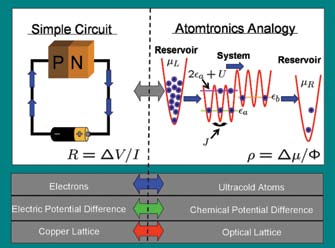Atomtronic devices
The atoms in the condensate flow as a current, which can be switched on and off like a normal circuit. Atomtronics uses atoms in strange quantum states to power devices or computer memory. This is different from spintronics, which stores information based on the spin of individual electrons, allowing each one to store two bits of data instead of one.
Computer scientists and particle physicists have made several advances in these fields in the past several months. Using atoms instead of electrons to process information could change the way we think about computing. In quantum computing we store a quantum state on an object, perform operations on the object and then read out the final state. If the system is not coherent, the initial stored information is lost.

Atoms trapped in optical lattices have been considered extensively for specific quantum computing schemes due to their inherent energy conserving characteristics. Therefore the dynamics of atomtronic devices would be coherent and potentially useful in quantum computing. It is also suggested that there is the possibility that atomtronics could be useful in obtaining sensitive measurements. It is thus concluded that atomtronic systems provide a nice test of fundamental concepts in condensed matter physics. While these ideas have been modeled, they are yet to be built.
Atomtronic diode
Atomtronic diode is a device that allows an atomic flux to flow across it in essentially only one direction. The atomtronic analogy of a diode is formed from the joining of p- and n-type semiconductor materials. Electrons are replaced by ultra-cold atoms, the battery is replaced by high and low chemical potential reservoirs, and the metallic crystal lattices (the microscopic medium that the electrons traverse) are replaced by an optical lattice. The atomtronic diode is achieved by energetically shifting one-half of the optical lattice with respect to the other.
The wires and atomtronic components are composed of optical lattices, and current refers to the number of atoms that pass a specifi point in a given amount of time. The desired function of an atomtronic transistor is to enable a weak atomtronic current to be amplified, or to switch on or off a much larger one. The team has also modeled an atomtronic transistor. The atomtronic version of transitor exhibits on/off switching behavior and acts as an amplifier.
By confiuring the optical lattice in a manner researchers show that it is possible to recover the characteristics of the conventional electronic transistor in the atomic world.
Limitations of atomtronics
Scientists are hoping to use the condensate in the way that superconductors have been used to make improved devices and sensors. Idea for a useful device was inspired by superconducting quantum interference devices, commonly known as SQUIDs. Scientists also believe that Bose-Einstein condensate could provide an extremely sensitive rotation sensor.
It is pointed out, however, that atomtronics probably won’t replace electronics as atoms are sluggish compared to electrons. This means it might be difficult to replace fast electronic devices with sluggish atomtronic devices.
The author is a professor in the department of physics at S.L.I.E.T., Longowal, Punjab






